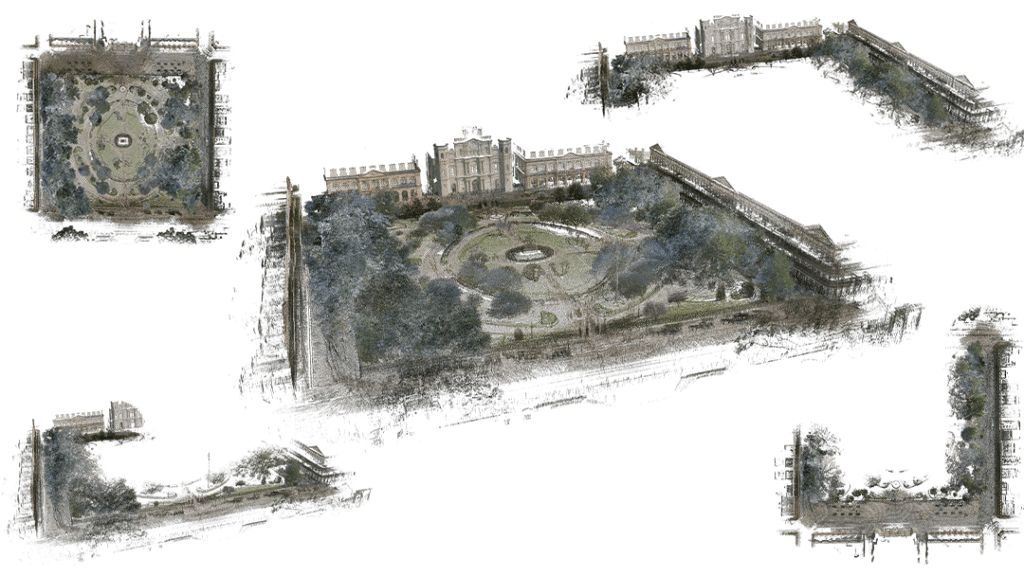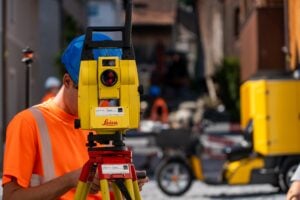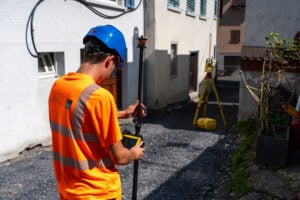
Was ist eine Punktwolke und wie wird diese mit Reality Cloud Studio, powered by HxDR genutzt?
Wird mit einem LiDAR-Scanner ein dreidimensionaler Raum vermessen und erfasst, wird eine sogenannte „Punktwolke“ generiert: Eine Sammlung von Millionen von 3D-Punkten, die zum Sensor zurückreflektiert und über Onboard-Software und Hardware verarbeitet werden.
Die Punktwolke ist der ersten Schritt bei der Erstellung eines 3D-Modells der realen Welt. Sie bildet eine Karte aus im Raum angeordneten Punkten, die wir in 3D-Modelle umwandeln können. Dabei kann alles dargestellt werden, ob Stadtansicht, historischen Stätte, Gebäude oder Produktionsanlage – und noch vieles mehr.
Wie wird eine Punktwolke erstellt? Ein Laserscanner von Leica Geosystems wie Leica RTC360 oder Leica BLK360, wird an der gewünschten Messposition auf einem Stativ aufgestellt und dann drücken Sie einfach die Starttaste. Der Laserscanner führt mit seinem LiDAR-System einen ersten Scan durch. Das integrierte Visual Inertial System (VIS) verfolgt anschließend den Scanner von Stationierung zu Stationierung und unterstützt uns dabei, die Daten der einzelnen Scans zu einer vollständigen, ganzheitlichen Punktwolke zusammenzufügen.
Sobald wir unsere Punktwolke erstellt haben, geht es weiter. Wir können diese riesige Sammlung von Punkten in ein 3D-Modell umwandeln. Dieser Prozess umfasst das Zusammenfügen überlappender Scans (Registrierung) sowie das Umwandeln der Punktwolkendaten in Polygone (Meshing), welche die Oberfläche der gescannten Objekte darstellen.

Wie vervollständigt die Registrierung eine Punktwolke?
Dieser Schritt der Registrierung bedarf weiterer Erläuterung. Wir sprechen erst dann von einer „vollständigen“ Punktwolke, wenn alle Scans zusammen registriert wurden.
Jede Punktwolke wird durch die Kombination von Einzelscans erstellt, d. h. wenn ein ganzes Gebäude oder ein weitläufiger Raum zur vollständigen Erfassung mehrmals gescannt wird, werden mehrere Punktwolken zusammen registriert. Nach der Registrierung werden die einzelnen Scans zu einem Datensatz zusammengefügt, der den realen Raum, das reale Objekt, das reale Gebäude oder was auch immer Sie gescannt haben, darstellt.
Die Registrierung ist ein wichtiger Schritt, um das Beste aus Ihren Daten herauszuholen, unabhängig davon, welchen Scanner Sie einsetzen. Ohne Registrierung erhalten Sie lediglich einzelne Punktwolken, die nicht alles abbilden, was Sie gescannt haben.
Hier kommt Reality Cloud Studio ins Spiel.

Wie werden Punktwolken verarbeitet, insbesondere in Reality Cloud Studio?
Mit bestimmten Scannerdaten kann Reality Cloud Studio den komplexen Registrierungsprozess für Sie übernehmen und schnell in der Cloud durchführen, sobald Sie die Daten hochgeladen haben. Reality Cloud Studio vereinfacht den unter Umständen schwierigen Prozess nicht nur, sondern automatisiert diesen ohne weiteres Eingreifen des Benutzers.
Noch wichtiger ist, dass Reality Cloud Studio die Punktwolken automatisch „vernetzt“. Das bedeutet, dass die winzigen Abstände zwischen den einzelnen Punkten in der Punktwolke gefüllt werden. Auf diese Weise entsteht ein einheitlicher, vollständiger und realitätsnaher Datensatz. Anschließend lässt sich Ihr Mesh einfach per Klick in dem Dateiformat, das für Ihren Workflow oder Ihre Kunden am besten geeignet ist, exportieren.
Reality Cloud Studio bietet in Kombination mit den benutzerfreundlichen Scannern von Leica Geosystems und deren Fähigkeit, Daten direkt aus dem Feld hochzuladen, einen einfachen, schnellen und vollständigen End-to-End-Workflow von der Datenerfassung bis zur Datenbereitstellung.
Nach dem Upload Ihrer Punktwolken und der automatisierten Speicherung und Verarbeitung lassen sich diese Daten teilen. Sie können die Scans vor Ort in Reality Cloud Studio hochladen und mit Ihrem Team im Büro teilen. Dank schneller Datenbearbeitung erhalten Ihre Kunden sehr schnell verwertbare Ergebnisse. Die Prozesse für Reality Capture umfassen nicht nur das Scannen, sondern auch die Registrierung und sind für jeden einfach zugänglich.

Sie möchten mehr Informationen dazu? Seien Sie gespannt auf den nächsten Artikel in dieser Serie: Was ist ein digitaler Zwilling?



